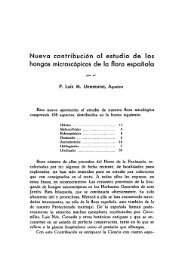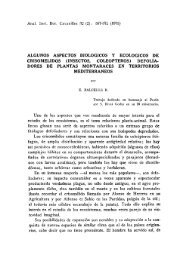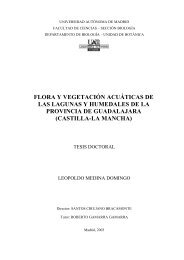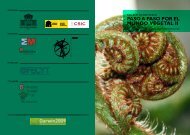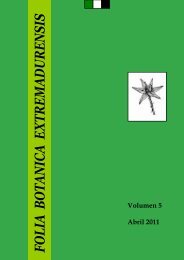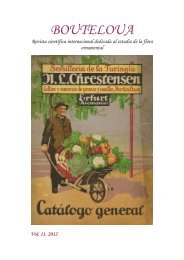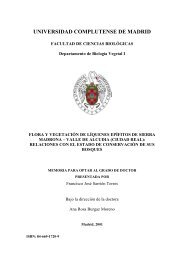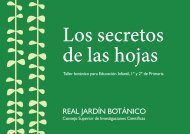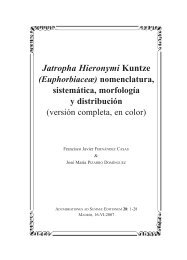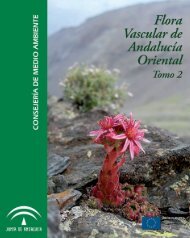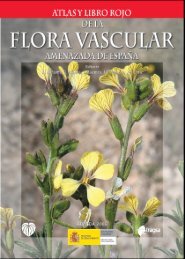bouteloua - Biblioteca digital del Real JardÃn Botánico de Madrid
bouteloua - Biblioteca digital del Real JardÃn Botánico de Madrid
bouteloua - Biblioteca digital del Real JardÃn Botánico de Madrid
- No tags were found...
You also want an ePaper? Increase the reach of your titles
YUMPU automatically turns print PDFs into web optimized ePapers that Google loves.
Bouteloua 1: 55-60 (XI-2006)Br. ex Fresen (Peris & Esteso 1987, Esteras1988). Like these taxa, Megathyrsus maximusvar. pubiglumis seems to thrive well and islocally escaping. The nomenclature andtaxonomy of this taxon un<strong>de</strong>rwent consi<strong>de</strong>rablemodifications recently (see above for majorsynonymy). After being <strong>de</strong>scribed initially as arepresentative of the genus Panicum, Webster(1987) transferred our taxon to the genusUrochloa on behalf of its particular lemmaornamentation. More recently Simon & Jacobs(2003) <strong>de</strong>monstrated that Panicum subgenusMegathyrsus (to which P. maximum belongs)should be elevated to generic rank andlegitimated the new combination Megathyrsusmaximus.II. Other Spanish records of exoticsubspontaneous grass speciesPennisetum clan<strong>de</strong>stinum Chiov.ALICANTE: Alicante, Babel, Barranco <strong>de</strong> lasOvejas, dry riverbed, several stands, 05-IX-2005, F. Verloove 6128 (priv. herb. author,dupl. MA); ALICANTE: Villajoiosa, riuAmadorio near the beach, 08-IX-2005, F.Verloove s.c.The African Pennisetum clan<strong>de</strong>stinum, betterknown un<strong>de</strong>r its vernacular name Kikuyu grass,is extensively cultivated as a forage or lawngrass in the (sub-) tropics. It is increasinglysown in lawns in southeastern Spain. Since1992 Pennisetum clan<strong>de</strong>stinum is reported as anescape from cultivation, primarily in theprovinces of Alicante (San Vicente <strong><strong>de</strong>l</strong> Raspeig)and Valencia (Valencia) (Herrero-Borgoñón &al. 1995). The above records confirm thespecies’ recent naturalization in the province ofAlicante. In both cases Pennisetumclan<strong>de</strong>stinum forms <strong>de</strong>nse, almost monospecificstands in or near riverbeds. As it is sometimesvery reluctant to flower (and even in flowervery indistinctive) it might have beenoverlooked elsewhere.The species is a <strong>de</strong>clared noxious weed inmany countries outsi<strong>de</strong> its natural range (see forinstance Missing 1984) and a future rapid andlocal expansion in Spain cannot be exclu<strong>de</strong>d.Pennisetum setaceum (Forssk.) Chiov.ALICANTE: Alicante, Babel, ru<strong>de</strong>ral roadverge of N332 near railway track in the harbour,one specimen, 08-IX-2005, F. Verloove 6107(MA); ALICANTE: El Campello towardsVillajoiosa, arid road verge of N332 (km 129-130), locally common, 08-IX-2005, F. Verloove6111 (BR)Pennisetum setaceum – presumably native innortheastern Africa and Arabia – is much grownas an ornamental in the more arid areas ofsouthern Europe (Walters & al. 1984). Crespo &al. (1990) reported about its first escape ofcultivation in Spain (El Campello, N332 km102) and continental Europe. The additionalrecords above confirm the recent naturalizationand spread of Pennisetum setaceum in this area.Moreover, since its original discovery in theprovince of Alicante, the species also occurredin the provinces of Granada, Malaga andValencia (Sanz Elorza & al. 2004).Pennisetum setaceum is one of the mostaggressive alien inva<strong>de</strong>rs in the Canary Islands,especially in the coastal areas (García-Gallo &al. 1999). Its eradication is time-consuming andvery expensive. Climatological an<strong>de</strong>nvironmental conditions are rather similar inparts of southeastern continental Spain and thespecies’ future invasive behaviour is very likely.DISCUSSIONInvasive alien organisms are consi<strong>de</strong>red to beamongst the most important reasons fordramatic biodiversity loss worldwi<strong>de</strong>. Someintroduced plants often naturalize remarkablywell and start outcompeting vulnerable nativeones, which often leads to extinction of rarespecies. Early <strong>de</strong>tection of such new alien,potentially invasive plant species is essential. Inthe present paper comments are provi<strong>de</strong>d aboutsome recently escaping cultivated grass species.The introduction on purpose of exotic grassspecies for road verge stabilization has becomecommon use in various parts of Spain. Most ofthe grasses that are introduced for such purposesare tall, fast growing and very competitive.They are, almost without exception, <strong>de</strong>clarednoxious weeds in their countries of origin aswell as in their secondary areas. Chloris gayanaand Eragrostis curvula for instance – both inrapid expansion in parts of Spain after theirinitial <strong><strong>de</strong>l</strong>iberate introduction – are well-knowndangerous weeds in various (warm-) temperateareas worldwi<strong>de</strong>. Surprisingly, they are stillmassively sown for local roadsi<strong>de</strong> stabilizationin Spain although at least Chloris gayana andPennisetum setaceum already has been reportedas aggressive inva<strong>de</strong>rs in Spain (Sanz Elorza &al. 2004; Dana & al. 2005). Moreover, from thispoint of view, the recent introduction ofMegathyrsus maximus for this purposes – also areputed noxious weed in many parts of theworld – appears to be very regrettable.AcknowledgementsI thank Elias Dana for his general help and SvenBellanger (National Botanic Gar<strong>de</strong>n of56



